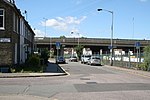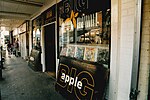Croydon Palace
Episcopal palaces of archbishops of CanterburyGrade I listed buildings in the London Borough of CroydonGrade I listed palacesHistory of the London Borough of CroydonHouses in the London Borough of Croydon

Croydon Palace, in Croydon, now part of south London, was the summer residence of the Archbishop of Canterbury for over 500 years. Regular visitors included Henry III and Queen Elizabeth I. Now known as Old Palace, the buildings are still in use as the Old Palace School, an independent girls' school of the Whitgift Foundation. It has been a grade I listed building since 1951.
Excerpt from the Wikipedia article Croydon Palace (License: CC BY-SA 3.0, Authors, Images).Croydon Palace
Old Palace Road, London Broad Green (London Borough of Croydon)
Geographical coordinates (GPS) Address Phone number Website Nearby Places Show on map
Geographical coordinates (GPS)
| Latitude | Longitude |
|---|---|
| N 51.372761111111 ° | E -0.10496944444444 ° |
Address
Old Palace of John Whitgift School
Old Palace Road 1
CR0 1AX London, Broad Green (London Borough of Croydon)
England, United Kingdom
Open on Google Maps










